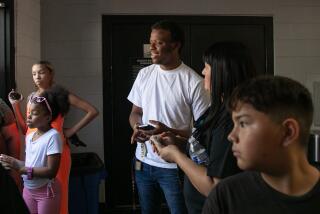Hawkins Jr. Gets 28 Years in Slaying : Family’s Stand Against Watts Gang After ’83 Death Won Praise
- Share via
James Hawkins Jr., whose family’s stand against a Watts street gang drew praise from law officers and politicians, was sentenced Monday to 28 years in prison for killing a young gang member whose death triggered the violent confrontation.
Hawkins, 41, who has a lengthy criminal record, received the maximum sentence of six years for voluntary manslaughter, two more years for committing the crime with a firearm and another 20 years because he had previously been convicted of four violent felonies.
“It is our contention that the defendant has committed crimes on the installment basis over the entirety of his life . . . ,” Deputy Dist. Atty. Harvey Giss said, as he asked Los Angeles Superior Court Judge Ronald S. W. Lew to impose the maximum sentence. “It’s our contention that a balloon payment is now due.”
Janis A. Rader, one of Hawkins’ two attorneys, said outside Lew’s courtroom that the sentence was “outrageously disproportionate” to the crime of which Hawkins was convicted.
“The court in my opinion continued to display a biased attitude toward the defendant,” Rader said.
“That ain’t no justice,” said Hawkins’ elderly father, James Hawkins Sr., who established the family’s businesses in Watts more than 40 years ago.
“It wasn’t no shock,” added the younger Hawkins’ wife, Helena. “It didn’t move me, because I knew they were going to go all the way.”
The bulk of the younger Hawkins’ sentence was imposed under provisions of a 1982 initiative known as the Victim’s Bill of Rights. The initiative instructs judges in sentencing criminals convicted of certain violent crimes to add five years to their prison terms for each previous similar conviction.
In Hawkins’ case, Lew imposed additional, consecutive five-year terms for a 1969 conviction for armed robbery in California, a 1974 conviction for armed robbery in Arkansas, a 1974 conviction for bank robbery in California and a 1975 conviction for assault with a deadly weapon on a California parole officer.
As he passed sentence, Lew said, “The defendant has engaged in a pattern of violent conduct which indicates a serious danger to society.”
Addressing Hawkins, the judge added, “I do feel the total of 28 years is sufficient and justified in this case, due to the crime alleged . . . and your criminal background.”
Before he was sentenced, Hawkins told the judge, “My conduct . . . was not criminal, your honor. I defended myself against an assault. My past conduct has nothing to do with me now. . . . I acted in good faith and ended up being charged with murder.”
Hawkins was found guilty last August of the less serious crime of voluntary manslaughter in the Sept. 11, 1983, shotgun death of Anttwon Thomas.
Thomas, 19, was a member of the Bounty Hunters gang based in the Nickerson Gardens housing project. The project is across the street from the Hawkins family grocery at Slater Avenue and Imperial Highway, on the border of Watts and Willowbrook.
Hawkins testified that Thomas died during a struggle that began after Hawkins stopped Thomas and other gang members from accosting a woman and her children near the Hawkins’ store. Minutes later, Hawkins said, Thomas walked into an arcade adjacent to the grocery.
As he tried to eject Thomas, Hawkins testified, Thomas pulled a sawed-off shotgun from the waistband of his trousers. During a struggle for the weapon, Hawkins said, the gun went off and fatally wounded Thomas.
Giss, however, produced witnesses whose recollections differed. Ed Lewis, a dispatcher for an alarm company, testified that he watched from across Imperial Highway as Hawkins walked from the arcade to a nearby trailer, retrieved a weapon that appeared to be a sawed-off shotgun and returned to shoot Thomas. Hawkins’ defense attorneys have repeatedly characterized Lewis’ testimony as unreliable and contradictory.
For two nights after Thomas’ death, gang members fired shots and hurled Molotov cocktails at the Hawkins store and the family’s adjacent home. Seventeen gang members were later convicted of crimes stemming from the assault.
Hawkins was not charged with the killing until the following April, four months after Lewis surfaced as a defense witness at a preliminary hearing for the gang members.
After the gang attack, but long before Hawkins was charged, Mayor Tom Bradly and other officials visited the Hawkins home and praised the family for its resolve in remaining in the neighborhood despite the gang attacks.
Hawkins and a co-defendant are currently awaiting trial on two other unrelated murder charges stemming from the June, 1984, shooting deaths of two reputed narcotics dealers.
Before sentencing, Lew denied motions for a new trial filed by Rader, co-counsel Stephen A. Schwartz and Hawkins, himself.
Hawkins asked the judge to set aside the verdict because of Schwartz’s alleged incompetence, saying that Schwartz’s “injudiciousness . . . aggravated the court to the degree of perhaps swaying the court in favor of the prosecution.”
Schwartz later declined comment on the accusation.
More to Read
Sign up for Essential California
The most important California stories and recommendations in your inbox every morning.
You may occasionally receive promotional content from the Los Angeles Times.













